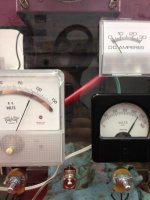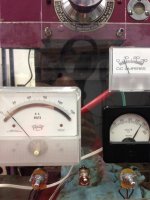With regards to Bill, and I have already purchased the Parker/Eurotherm drive combo on his and Mark's advice, I have wondered for some years whether the KB PWM controls would work on the Monarch. I use the KB PWM controls with PM motors on my SB9, SB10L, and Clausing 8520 mill and have been more than satisfied with their smoothness and power.
I am using a KBWT-210 for the armature and a KBWT-26 for the field, both 240 VAC input.

Ignore the rats nest wiring, I just wanted them mounted where I could get to them easily and connect to my test panel. If they do prove successful, I'll probably mount everything on a homemade drawer on the WIAD slides.
At nominal voltages, 230 VDC armature, 115 VDC field, I get nominal RPM.


And these are the values at 4000 RPM


The KBWT-210 will go to just over 240 volts, so it has the reserve for the IR compensation to be effective. The unknown at this point is how much load I will put on the machine. I don't plan on taking 1/4 cuts in steel. In the coming months as I get the lathe back together I'll measure loads for different cuts. I'll have my completely rebearinged apron on the lathe in a couple of days, the gearbox and ELSR assembly will probably be a few more months. Since as I have mentioned I can make my own gears, I have designed a coupling device that will operate both pots properly with one knob. That will be my next project after the apron. With regards to reversing, I think I will just wire in relays myself like the WIAD circuit, that way I can reverse the armature, but keep the series field at the same polarity.
I am using a KBWT-210 for the armature and a KBWT-26 for the field, both 240 VAC input.

Ignore the rats nest wiring, I just wanted them mounted where I could get to them easily and connect to my test panel. If they do prove successful, I'll probably mount everything on a homemade drawer on the WIAD slides.
At nominal voltages, 230 VDC armature, 115 VDC field, I get nominal RPM.


And these are the values at 4000 RPM


The KBWT-210 will go to just over 240 volts, so it has the reserve for the IR compensation to be effective. The unknown at this point is how much load I will put on the machine. I don't plan on taking 1/4 cuts in steel. In the coming months as I get the lathe back together I'll measure loads for different cuts. I'll have my completely rebearinged apron on the lathe in a couple of days, the gearbox and ELSR assembly will probably be a few more months. Since as I have mentioned I can make my own gears, I have designed a coupling device that will operate both pots properly with one knob. That will be my next project after the apron. With regards to reversing, I think I will just wire in relays myself like the WIAD circuit, that way I can reverse the armature, but keep the series field at the same polarity.



